Loreto is a region in Mexico known for its incredible bird-watching opportunities. With nearly 400 different species of birds, it is one of the most diverse and exciting bird-watching destinations in the world.
From tropical hummingbirds to majestic eagles, there is something for everyone to enjoy. With a variety of habitats and micro-climates, Loreto is home to a wide variety of bird species, including both migratory and resident birds.
Whether you’re a beginner or an experienced birder, Loreto is the perfect place to observe and appreciate a variety of avian species.
1. Hummingbirds
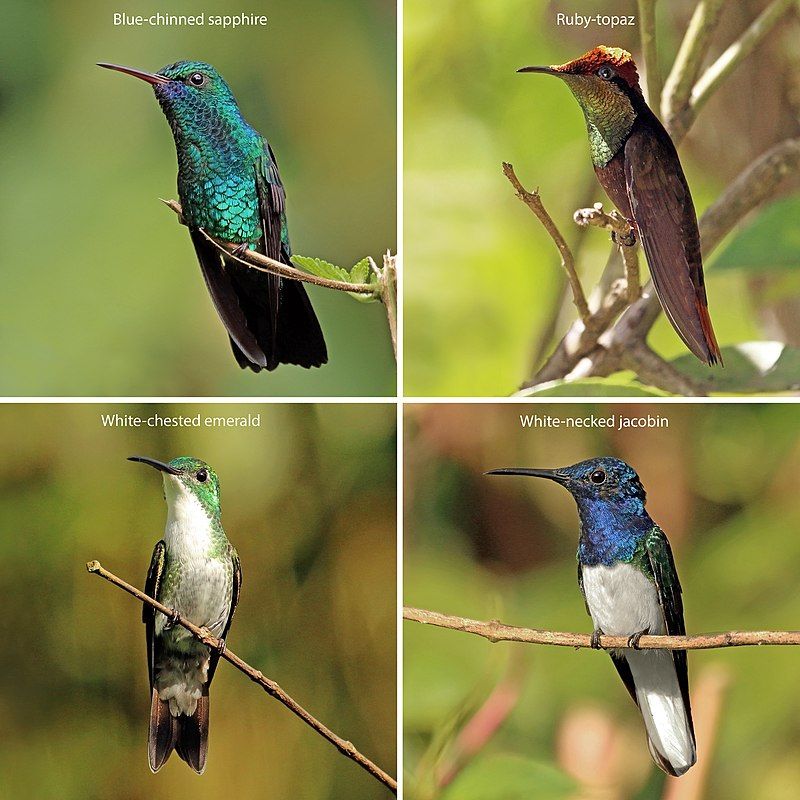
Hummingbirds are small birds that belong to a single biological family, Trochilidae, which can be found in the Americas. There are over 366 species of hummingbirds, spread over 113 genera. These birds are found in a variety of habitats, ranging from Alaska to Tierra del Fuego.
However, the majority of hummingbird species are concentrated in Central and South America, where they can be found in all kinds of diverse ecosystems. Hummingbirds are quite unique, especially due to their ability to fly in all directions, including backward.
They are also known for their unique vocalizations, which range from high-pitched chirps to complex songs. They are a popular bird species among birdwatchers, as they are colorful and often quite easy to spot.
| Kingdom | Animalia |
| Phylum | Chordata |
| Class | Aves |
| Clade | Strisores |
| Order | Apodiformes |
| Family | Trochilidae |
2. White-winged Dove
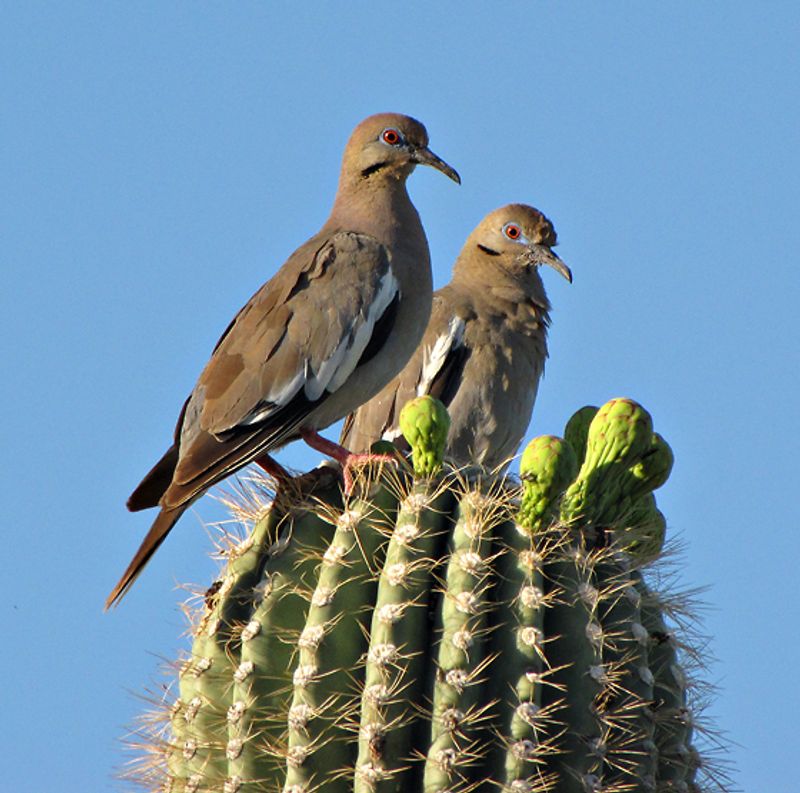
The white-winged dove is a species of dove native to the Southwestern United States, Mexico, Central America, and the Caribbean. It is larger than other doves and is easily identifiable by the white edging along its wings.
Its distinguishing physical features include blue eyering and red eyes. The dove is usually found in open woodlands and grasslands and prefers to feed on the ground on seeds and grains.
They are generally solitary or found in pairs, and can often be heard cooing in the early mornings or late evenings. The white-winged dove is a symbol of peace and serenity, and its presence is a sign of hope and good luck.
| Kingdom | Animalia |
| Phylum | Chordata |
| Class | Aves |
| Order | Columbiformes |
| Family | Columbidae |
| Genus | Zenaida |
| Species | Z. asiatica |
3. Costa’s Hummingbird
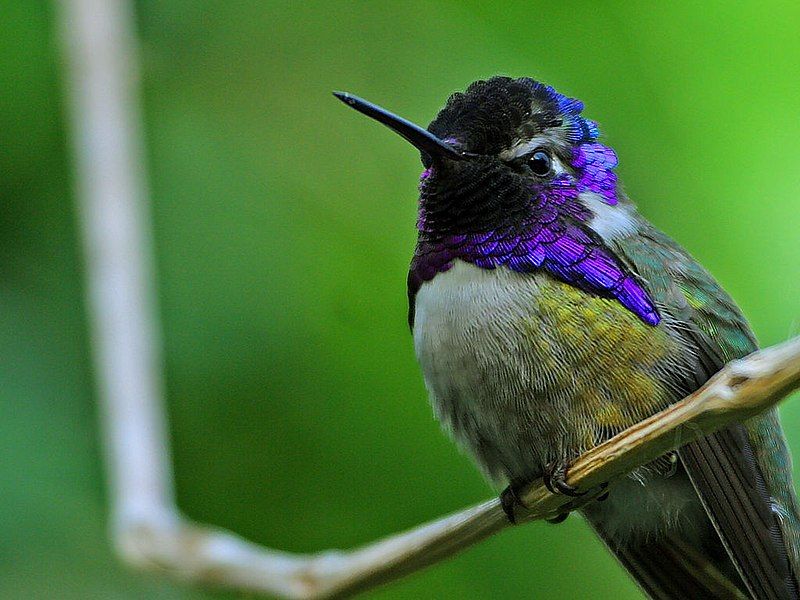
Costa’s hummingbird is an iconic species of the hummingbird family, Trochilidae. It is native to the arid regions of the southwest United States and northwest Mexico. During the winter months, this species migrates south to western Mexico, where it spends the colder season.
The bird has stunningly vibrant plumage, with glossy green upperparts, and distinctive purple and pink throat feathers. It is popular among birdwatchers and photographers due to its bright iridescent feathers.
In addition to its beauty, this species is also known for its remarkable flying abilities, such as hovering in one spot and flying backward.
Costa’s hummingbird is a unique species that plays an important role in its native habitat, pollinating numerous plants and providing food for other animals.
| Kingdom | Animalia |
| Phylum | Chordata |
| Class | Aves |
| Clade | Strisores |
| Order | Apodiformes |
| Family | Trochilidae |
| Genus | Calypte |
| Species | C. costae |
4. Columbidae
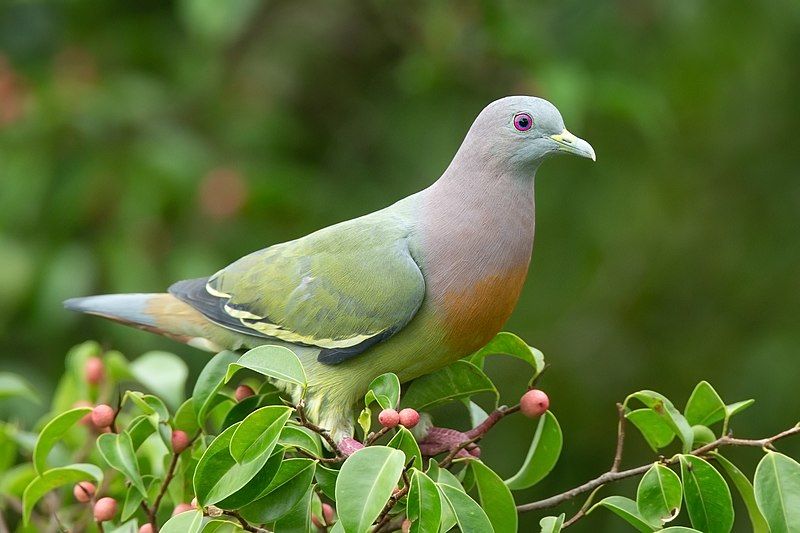
Columbidae is a family of birds that includes doves and pigeons and is the sole family in the order Columbiformes. These birds are generally stout-bodied with short necks and slender bills, some of which may feature fleshy ceres.
Columbidae mainly feed on seeds, fruits, and plants. They can often be found in many different habitats, from open fields and grasslands to woodlands and gardens.
Columbidae are also known to have quite diverse diets, with some species being omnivores and others specializing in a certain type of food. For example, some doves and pigeons eat mostly fruits, while others may prefer nuts and seeds.
The family is quite varied in terms of size, with some species being as small as 5 inches in length, while others can grow up to 24 inches long.
Columbidae is also known for their ability to fly great distances, with some migratory species traveling thousands of miles in order to find food and a suitable habitat.
| Kingdom | Animalia |
| Phylum | Chordata |
| Class | Aves |
| Clade | Columbimorphae |
| Order | Columbiformes |
| Family | Columbidae |
5. Turkey Vulture
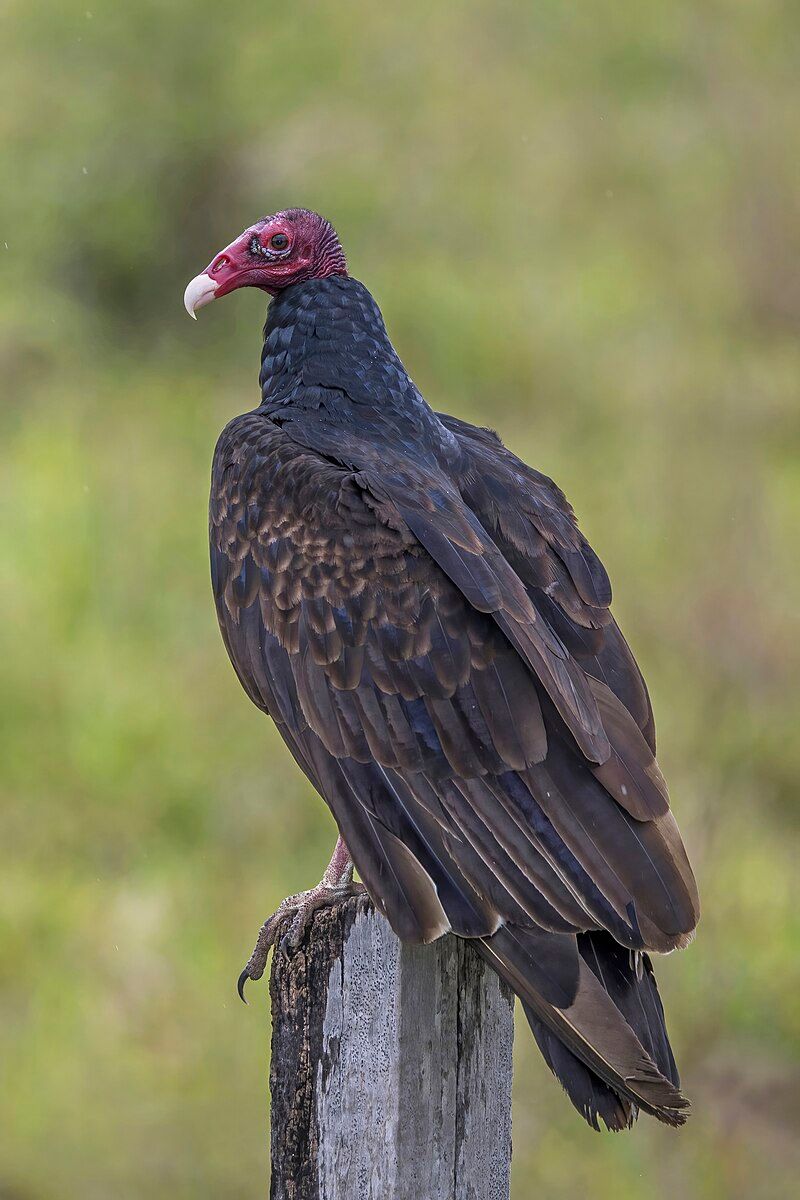
The turkey vulture is an important species of bird native to the Americas. It belongs to the genus Cathartes of the family Cathartidae and is the most widespread of the New World vultures.
Its range stretches from southern Canada all the way to the southernmost tip of South America.
Its scientific name, Cathartes aura, is derived from the Greek words for “purifier” and “breeze”, which reflects its role in the environment as a scavenger. Turkey vultures are large birds, with a wingspan of about five feet.
They are primarily black in color, with a white head and red wattle. Their long, broad wings enable them to soar for hours without flapping.
They feed on carrion, meaning they are essential in cleaning up dead animals and returning vital nutrients to the environment. Turkey’s vultures are also known for their intelligence and social behavior.
They often roost and fly together in large groups, which helps them locate food more efficiently.
They have also been known to use a variety of vocalizations, as well as display behaviors, to communicate with one another. The turkey vulture is an important species of bird that plays a vital role in maintaining the health of the ecosystems in which it lives.
Its range is vast, and its presence is essential to the environment.
| Kingdom | Animalia |
| Phylum | Chordata |
| Class | Aves |
| Order | Accipitriformes |
| Family | Cathartidae |
| Genus | Cathartes |
| Species | C. aura |
6. Osprey
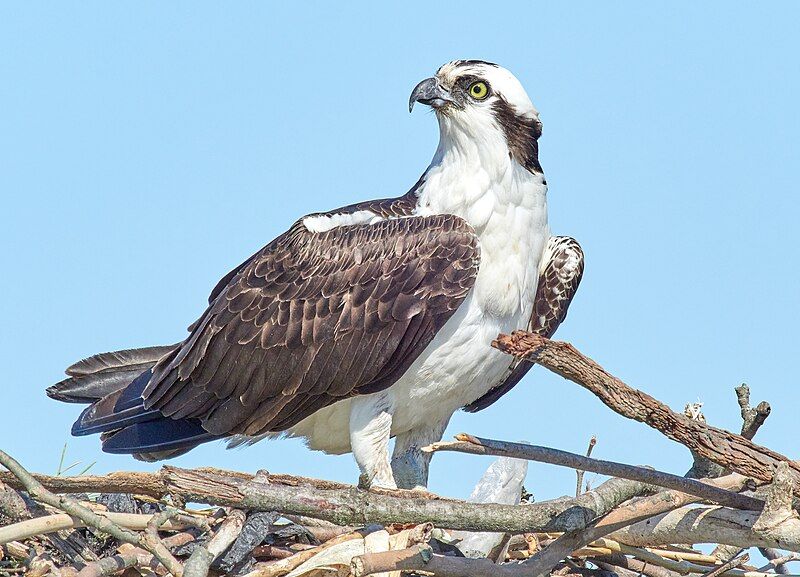
The osprey is a large bird of prey that can be found in many parts of the world. It is also known by different names including sea hawk, river hawk, and fish hawk.
The osprey is a diurnal species, meaning it is active during the day, and it has a diet that mainly consists of fish. On average, the osprey is about 60 centimeters in length and its wingspan can reach up to 180 centimeters.
Its upper parts are brown and its head and underparts are mostly greyish in color.
| Kingdom | Animalia |
| Phylum | Chordata |
| Class | Aves |
| Order | Accipitriformes |
| Family | Pandionidae |
| Genus | Pandion |
| Species | P. haliaetus |
7. American Oystercatcher
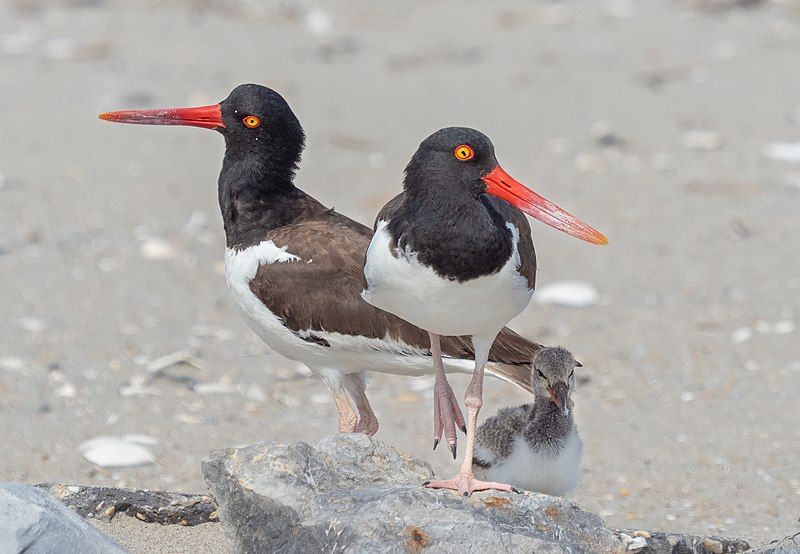
The American oystercatcher is a species of bird belonging to the family Haematopodidae. It has many different names, including the American pied oystercatcher and PiruPiru. Historically, it was also referred to as the “sea pie”.
This species has a long and interesting history, with the first recorded observation occurring in 1731 when English naturalist Mark Catesby noticed the bird eating oysters. Since then, the American oystercatcher has been a popular subject of study for ornithologists.
The American oystercatcher is a medium-sized wading bird, with a body length of between 45-50 centimeters. It has a black head, white underparts, and a distinctive black-and-white striped back. Its bill is long and pointed, enabling it to easily crack open oysters.
The bird’s legs are also long and bright yellow in color. The American oystercatcher can be found along the Atlantic and Gulf coasts of the United States, from Maine to Texas. It often prefers to inhabit rocky coastlines, where it can find plenty of oysters to eat.
It also feeds on mussels, clams, worms, and other marine invertebrates. The American oystercatcher often nests in large colonies, with each pair defending its own territory. The American oystercatcher is a species of conservation concern, due to its declining population.
Factors such as habitat loss, predation, and human disturbance have all contributed to the bird’s decline.
Conservation efforts are underway to help protect this species and its habitat, including the creation of protected areas for nesting and the implementation of regulations to reduce human disturbance.
| Kingdom | Animalia |
| Phylum | Chordata |
| Class | Aves |
| Order | Charadriiformes |
| Family | Haematopodidae |
| Genus | Haematopus |
| Species | H. palliatus |
8. Magnificent Frigatebird
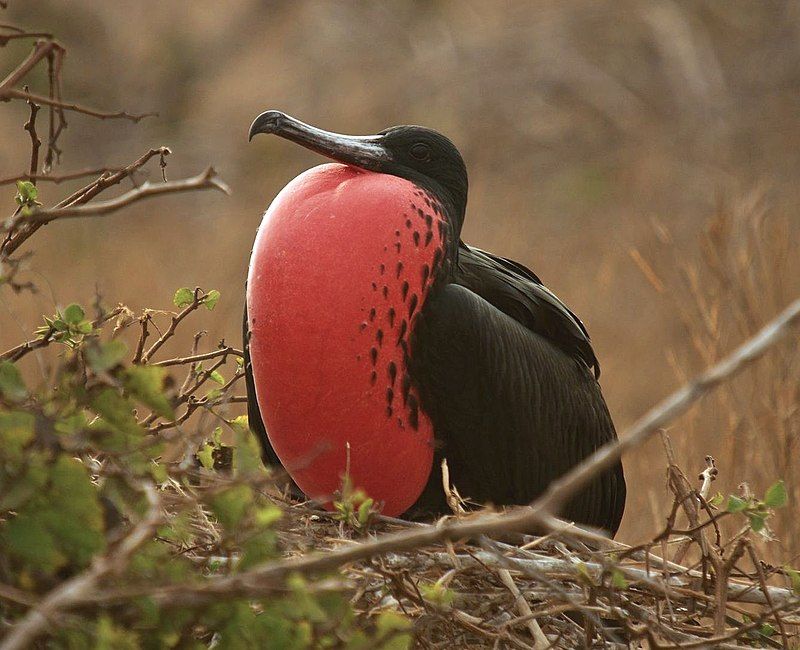
The magnificent frigatebird is a species of seabird belonging to the Fregatidae family. It is renowned for its size, with a length of 89-114 cm and an impressive wingspan of 2.17-2.44 m, making it the largest species of frigatebird.
Its wings are long and pointed, and the feathers on its back are iridescently black. Its underparts are white, and its head is adorned with a mohawk of long, white feathers, which it can erect during courtship displays. It has a long, forked tail with a white tip.
The magnificent frigatebird is an adept and powerful flier, capable of soaring for hours at a time without flapping its wings. Its diet mainly consists of fish and squid, which it captures by swooping down from the sky, sometimes snatching food from other birds.
It also scavenges and will steal food from the catches of other birds, such as boobies and terns. Nesting, which occurs year-round in tropical and subtropical regions, takes place in colonies on offshore islands. The female lays a single egg in a nest built on the ground.
Both parents take turns incubating the egg, which takes around 50 days to hatch. The chick remains in the nest for six months and is fed by both parents until it reaches maturity.
The magnificent frigatebird is a remarkable species of seabird and one of the largest species of frigatebird. Its impressive size, powerful flight, and thieving behavior make it an iconic species of the ocean..
| Kingdom | Animalia |
| Phylum | Chordata |
| Class | Aves |
| Order | Suliformes |
| Family | Fregatidae |
| Genus | Fregata |
| Species | F. magnificens |
9. Xantus’s Hummingbird
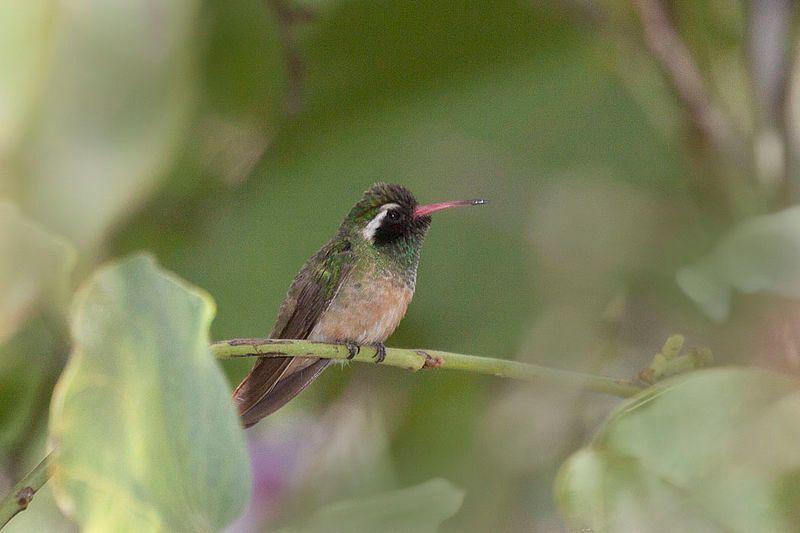
Xantus’s hummingbird is a species of hummingbird that is endemic to the Baja California Peninsula. It was previously known as the black-fronted hummingbird and is part of the Trochilini tribe, which is a part of the Trochilinae subfamily.
This subfamily is also known as the “emeralds” due to the bright and vibrant colors of the hummingbird species that belong to it. Xantus’s hummingbird is characterized by its unique black front, which sets it apart from other species in the Trochilini tribe.
This species of hummingbird is mainly seen in the coastal regions of the Baja California Peninsula and is rarely seen in other areas of the world.
The Xantus’s hummingbird is an important species in the Trochilini tribe, as its bright colors and unique black front add to the beauty and diversity of the Trochilini species.
| Kingdom | Animalia |
| Phylum | Chordata |
| Class | Aves |
| Clade | Strisores |
| Order | Apodiformes |
| Family | Trochilidae |
| Genus | Basilinna |
| Species | B. xantusii |
10. Black-necked Stilt
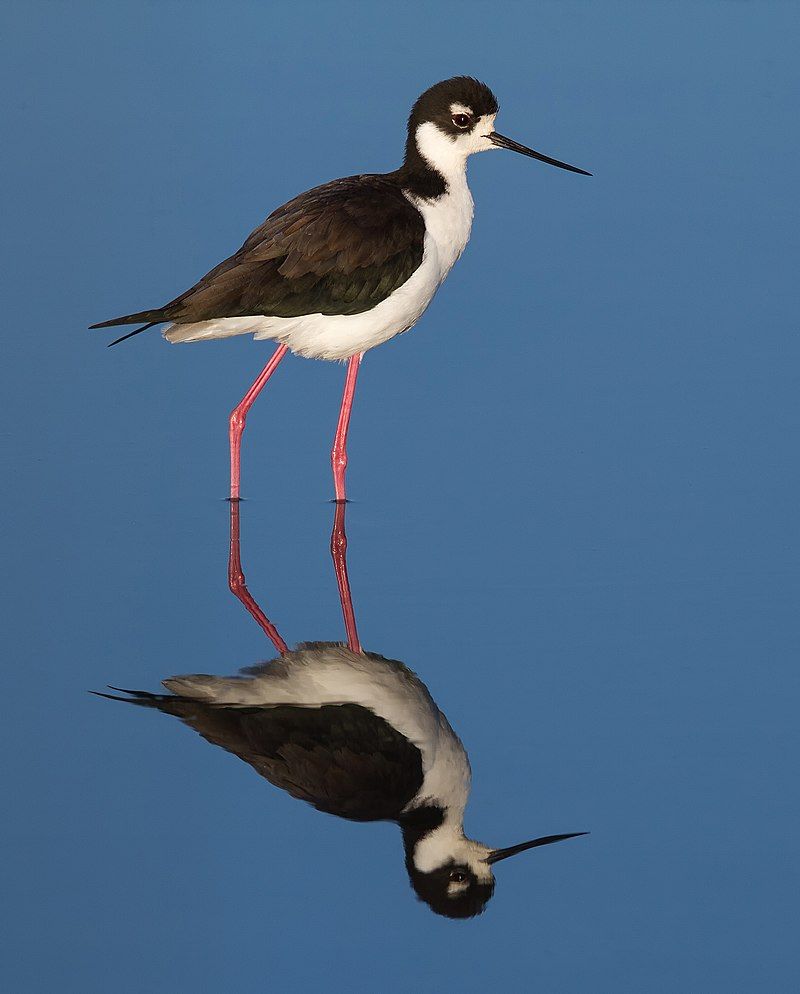
The black-necked stilt is a shorebird found in wetlands and coastal areas of the United States. It is abundant in coastal California and extends through the interior western states.
The black-necked stilt is also found in coastal areas along the Gulf of Mexico, the Atlantic Coast, and the Great Lakes. It is also found in Hawaii, the Caribbean, and parts of Mexico. The black-necked stilt has black and white plumage with long thin black legs.
Its long, slender beak is bright red and its head is black with a white crown. It has a bright white throat and underparts.
The black-necked stilt feeds on insects, aquatic invertebrates, and small fish. The black-necked stilt is a social species and can be seen in large flocks of up to several hundred individuals. It nests in shallow water, usually in colonies with other shorebirds.
The nest is a simple depression in the ground lined with vegetation. The female lays three to five eggs which the male and female both incubate.
Both parents also help feed the young. The black-necked stilt is an important species in many wetland ecosystems, providing food for other animals and contributing to nutrient cycling. It is currently listed as a species of Least Concern by the IUCN.
| Kingdom | Animalia |
| Phylum | Chordata |
| Class | Aves |
| Order | Charadriiformes |
| Family | Recurvirostridae |
| Genus | Himantopus |
| Species | H. mexicanus |
11. Anna’s Hummingbird
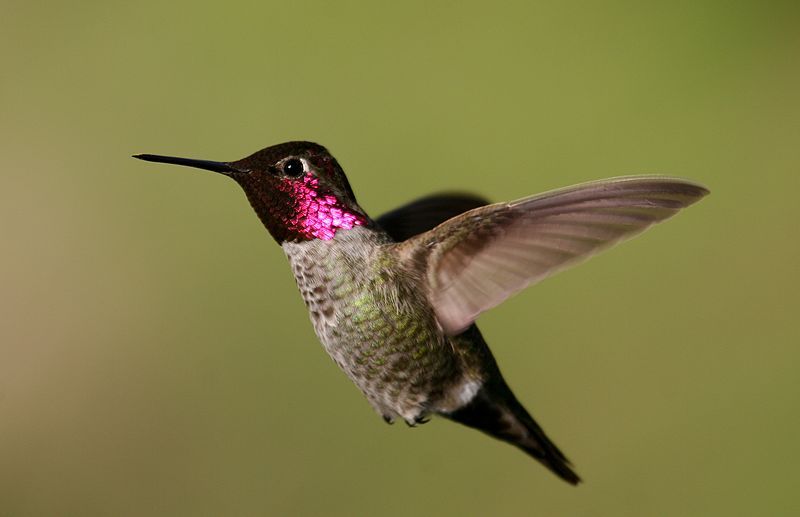
Anna’s hummingbird is a species of hummingbird native to North America. It was named after Anna Masséna, Duchess of Rivoli, and is most commonly found along the western coastlines of the continent.
In the early twentieth century, Anna’s hummingbirds bred mainly in two distinct regions of the continent: northern Baja California and Southern California. This species of hummingbird is a small, vibrant bird that has a ruby-red throat and crown.
The body is primarily gray with greenish-black wings. It is very active and fast-moving and is known to zip back and forth through the air while making a buzzing sound.
Anna’s hummingbirds are also known to be very territorial and will aggressively defend their area from intruders. Anna’s hummingbirds feed on small insects, nectar, and sap from trees.
They are commonly found in urban areas and gardens and have been known to visit feeders set out by humans.
They will also visit flowers to collect nectar and use their long tongues to lick up the sweet liquid. Overall, the Anna’s hummingbird is an iconic species of North American wildlife.
It was named after Anna Masséna, Duchess of Rivoli, and is known for its vibrant colors and territorial behavior.
This species is most often found in western coastal regions, especially in the early twentieth century when it was mainly found in northern Baja California and Southern California. Anna’s hummingbirds are important pollinators and serve an important role in the local ecology.
| Kingdom | Animalia |
| Phylum | Chordata |
| Class | Aves |
| Clade | Strisores |
| Order | Apodiformes |
| Family | Trochilidae |
| Genus | Calypte |
| Species | C. anna |
12. Black Bellied Plover
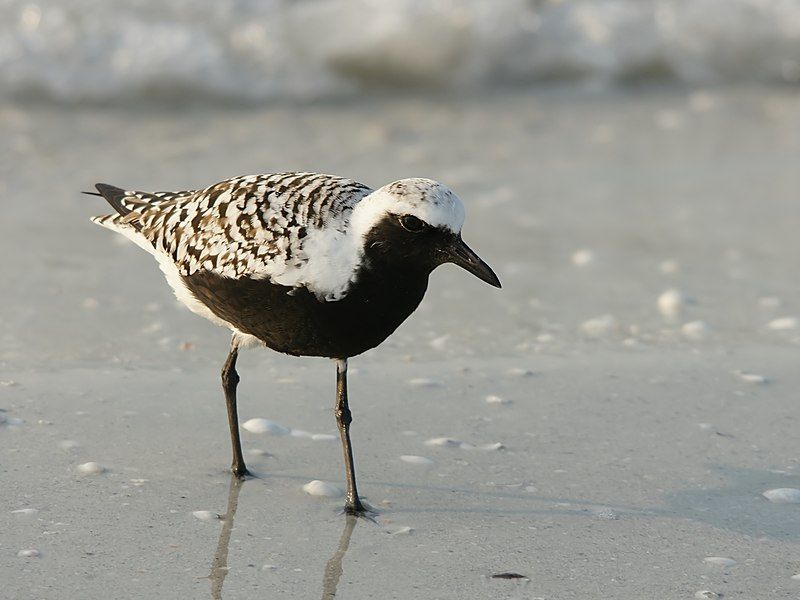
The grey plover, also known as the black-bellied plover in North America, is a large bird species that breeds in the Arctic regions. It is a cosmopolitan species, meaning it is found throughout the world.
During breeding season, it is mainly found in Arctic regions, but during other times of the year, its distribution is widespread along coastal areas.
This is because the grey plover is a long-distance migrant, which means that it travels great distances to different regions of the world. As a result, the grey plover has a nearly worldwide coastal distribution when it is not breeding.
The grey plover is an adaptable species and is able to survive in many different types of habitats, from coastal areas to inland grasslands.
| Kingdom | Animalia |
| Phylum | Chordata |
| Class | Aves |
| Order | Charadriiformes |
| Family | Charadriidae |
| Genus | Pluvialis |
| Species | P. squatarola |
13. Broad-billed Hummingbird
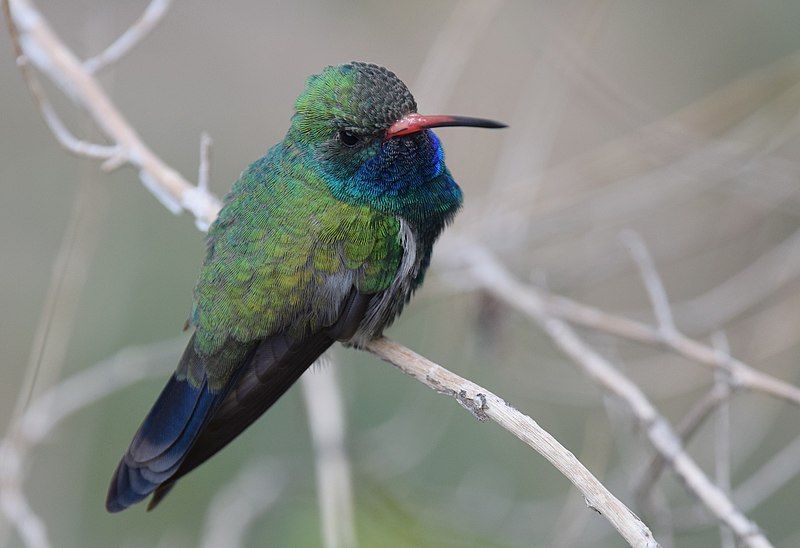
The Broad-billed Hummingbird is a species of hummingbird that is native to Mexico and the southwestern United States. This species of hummingbird is small in size and displays sexual dimorphism, which is when males and females of a species look different from each other.
The juveniles of this species resemble the female adult more than the male adult. In terms of coloration, the Broad-billed Hummingbird is a bright and colorful bird, with a broad and bright red bill.
This bill is a distinguishing feature of this species of hummingbird and helps to differentiate it from other species of hummingbirds. The red bill is a defining characteristic of the Broad-billed Hummingbird and helps to distinguish it from other species of hummingbirds.
The bright coloration and broad bill make this species of hummingbird a beautiful and interesting bird to observe.
| Kingdom | Animalia |
| Phylum | Chordata |
| Class | Aves |
| Clade | Strisores |
| Order | Apodiformes |
| Family | Trochilidae |
| Genus | Cynanthus |
| Species | C. latirostris |
14. Muscovy Duck
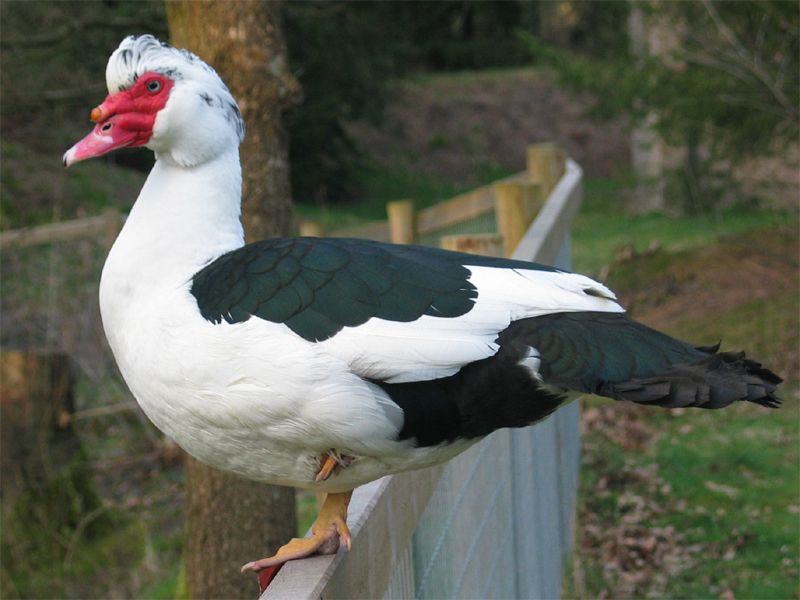
The Muscovy duck is a species of duck native to the Americas, with a range extending from the Rio Grande Valley of Texas and Mexico, south to Argentina and Uruguay.
This species of duck is also found living in the wild in many other areas of the world, such as in New Zealand, Australia, and Central and Eastern Europe. The Muscovy duck is a large duck, with males typically weighing up to 14 pounds.
They are often seen in groups in wetlands, and they are omnivorous, meaning they feed on both plants and animals. The Muscovy duck is an important food source for many people in its native range, as well as in the areas where it has been introduced.
The Muscovy duck is also a popular pet, often kept in aviaries or in ponds, and it is becoming increasingly popular in urban areas.
| Kingdom | Animalia |
| Phylum | Chordata |
| Class | Aves |
| Order | Anseriformes |
| Family | Anatidae |
| Genus | Cairina |
| Species | C. moschata |
15. Common Poorwill
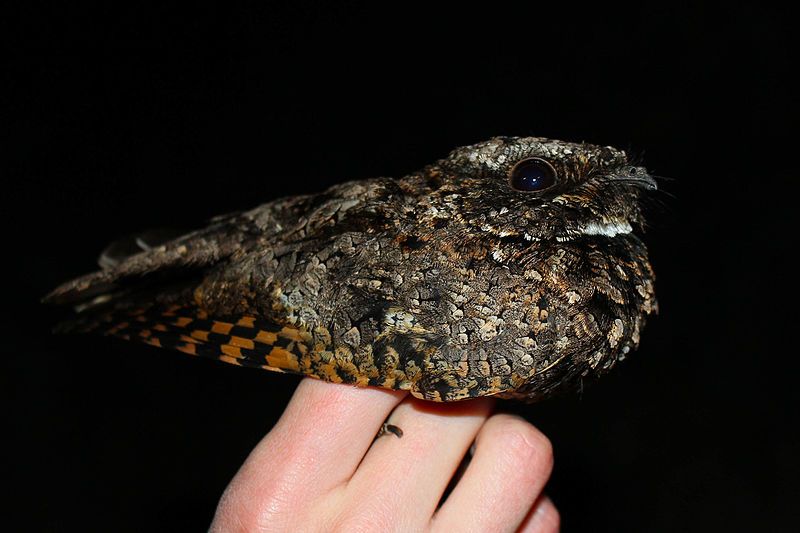
The common poorwill is a nocturnal bird of the family Caprimulgidae, commonly known as nightjars. It is found in a wide range of habitats that range from British Columbia and southeastern Alberta, across the western United States to northern Mexico.
Its preferred habitat is dry, open areas with grasses and shrubs, and it can even be found in stony desert slopes with very little vegetation.
This species is well-adapted to a range of habitats and is able to survive in areas with minimal vegetation. The common poorwill is a ground-dwelling bird that spends most of its time in search of food.
It primarily feeds on insects and other arthropods that it finds on the ground. Its diet consists of moths, beetles, crickets, grasshoppers, and other insects.
During the night, the common poorwill will perch on a branch or post and wait for prey to pass by. The common poorwill is well camouflaged with a mottled brown and gray plumage, which helps it blend in with its surroundings. It has short, rounded wings and a short tail.
The male and female common poorwill have similar plumage and size. The common poor is an important part of the food chain in its natural habitat. Its presence helps to maintain a healthy insect population, which in turn supports other wildlife and plant life.
The common poorwill is also a keystone species, meaning it plays an important role in maintaining the balance of its natural habitat.
| Kingdom | Animalia |
| Phylum | Chordata |
| Class | Aves |
| Clade | Strisores |
| Order | Caprimulgiformes |
| Family | Caprimulgidae |
| Genus | Phalaenoptilus |
| Species | P. nuttallii |
16. Marbled Godwit
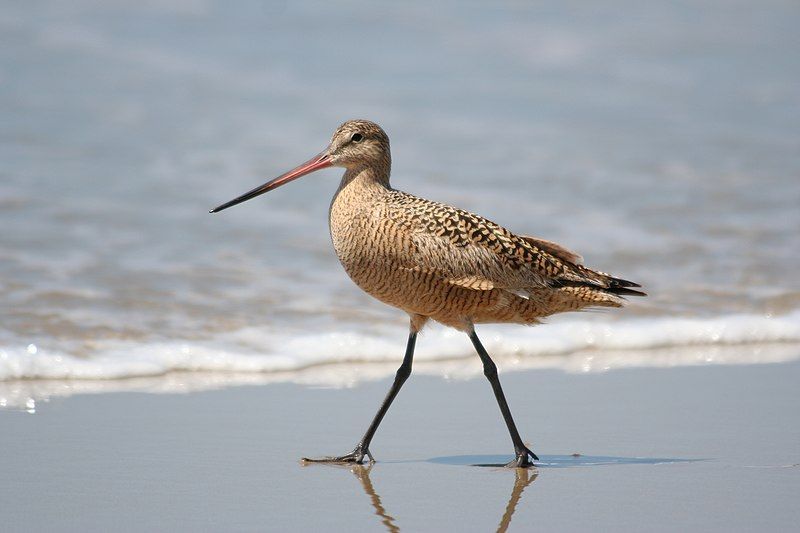
The marbled godwit is a large shorebird belonging to the family Scolopacidae, which includes other species of shorebirds, such as curlews and sandpipers. It is a migratory species, meaning it moves seasonally between different regions in order to breed or find food.
On average, the marbled godwit is the largest of the four species of godwit, with a length of up to 22 inches and a wingspan of up to 33 inches. Its wings are long and rounded and its bill has a slight upturn.
Its plumage is mostly grayish-brown, with a lighter white underbelly and a light brown head. The marbled godwit is quite a sight to behold, particularly when it takes flight. Its wings make a distinctive whirring sound as it soars through the sky.
The marbled godwit typically feeds on aquatic invertebrates, though it will also consume plant matter when available. It is a social bird, often gathering in large flocks during migration and in winter.
| Kingdom | Animalia |
| Phylum | Chordata |
| Class | Aves |
| Order | Charadriiformes |
| Family | Scolopacidae |
| Genus | Limosa |
| Species | L. fedoa |
17. Long-billed Curlew
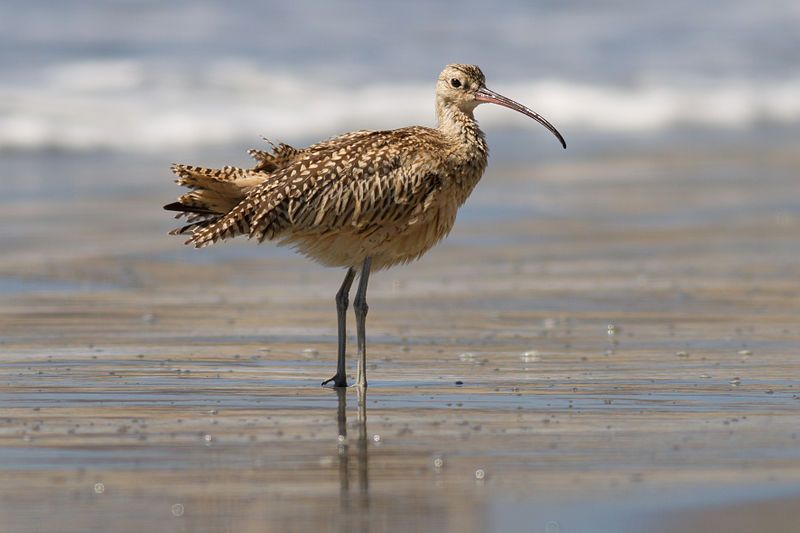
The long-billed curlew is an impressive shorebird native to North America. It belongs to the family Scolopacidae, and is also widely known by the names “sickle-bird” and “candlestick bird”.
The bird breeds in the central and western parts of North America and is known to migrate southward and towards the coast during the winter season. The long-billed curlew is a large bird, distinguished by its long, curved bill.
Its body is mostly mottled grey, with darker feathers on the wings and tail. The underside of the body is a pale greyish-white color.
The long-billed curlew feeds on insects, worms, crustaceans, and other small invertebrates, which it can find in the mudflats, sand banks, and tidal flats where it lives. The long-billed curlew is an important part of North American wildlife.
Its populations have been declining in recent years due to loss of habitat, and it is now listed on the IUCN Red List of Threatened Species. Conservation efforts are underway to protect the species and its habitats.
| Kingdom | Animalia |
| Phylum | Chordata |
| Class | Aves |
| Order | Charadriiformes |
| Family | Scolopacidae |
| Genus | Numenius |
| Species | N. americanus |
18. Brant
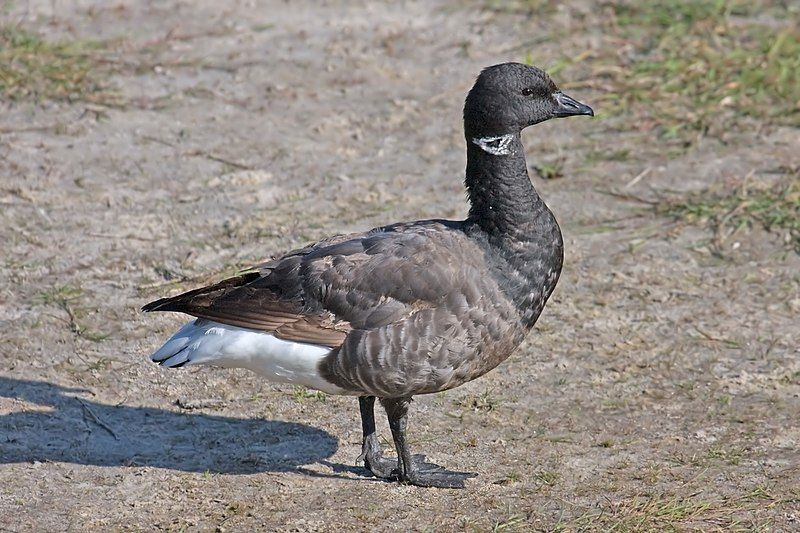
The brant or Brent goose is a species of small goose belonging to the genus Branta. There are three distinct subspecies of this species, which migrate to temperate-zone sea-coasts during winter and breed in the high-Arctic tundra during the summer.
This species of goose is well-known for its long-distance travels to and from the Arctic Circle, making it a notable bird in many parts of the world. The Brent oilfield is an offshore oilfield located in the North Sea between Norway and the United Kingdom.
It was named after the species of wild goose due to its close proximity to the bird’s wintering and breeding grounds. The oilfield is comprised of four platforms and is one of the largest oilfields in the world, producing approximately 500,000 barrels of oil per day.
It is an important economic resource for the countries that share its waters.
| Kingdom | Animalia |
| Phylum | Chordata |
| Class | Aves |
| Order | Anseriformes |
| Family | Anatidae |
| Genus | Branta |
| Species | B. bernicla |
19. Wilson’s Plover
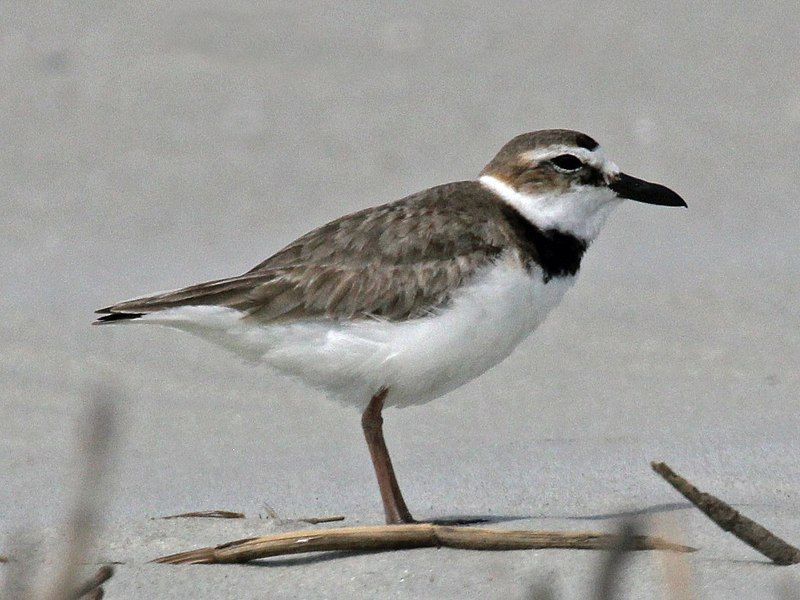
Wilson’s plover is a species of small bird that belongs to the family of birds called Charadriidae. This bird was named after the famous Scottish-American ornithologist Alexander Wilson by his friend George Ord in 1814.
Wilson’s plover is a coastal wader species, which means that it prefers to live near the coast and can be found along both the Eastern and the Western coasts of America from the equator up to more northern areas.
During the breeding season, this species can be seen in these areas and is known to build its nests in the ground. The plover is a medium-sized bird, with a length of around 18 cm and a wingspan of around 35 cm.
Its plumage is mostly gray, with white underparts and a distinctive black throat patch. It has a short black bill and long, yellowish legs.
This species feeds mainly on insects and other small invertebrates, which it finds in the mudflats, sand beaches, and tidal flats where it lives. It is an important coastal species and is considered vulnerable due to habitat loss and human disturbance.
| Kingdom | Animalia |
| Phylum | Chordata |
| Class | Aves |
| Order | Charadriiformes |
| Family | Charadriidae |
| Genus | Charadrius |
| Species | C. wilsonia |
20. Heermann’s Gull
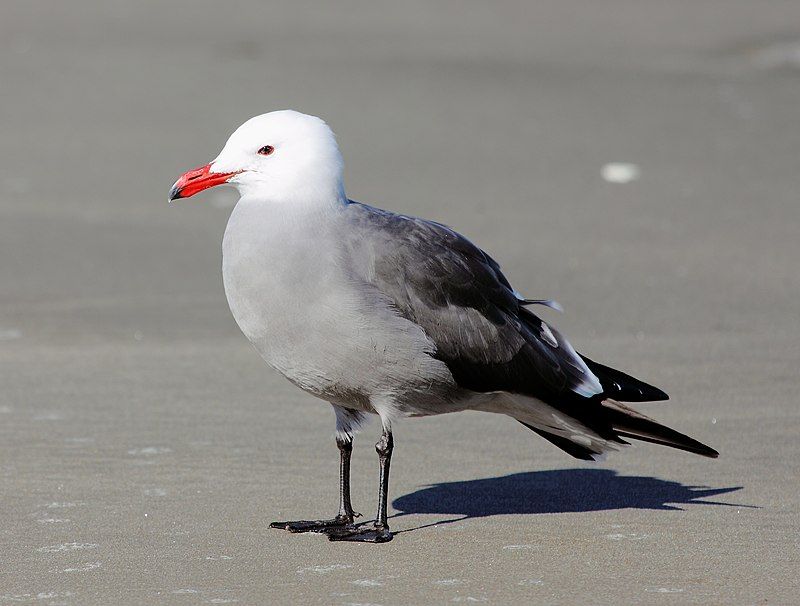
Heermann’s gull is a species of gull that is native to the United States, Mexico, and southwestern British Columbia. It is a coastal species and is rarely seen inland. The majority of the Heermann’s gulls nest on Isla Rasa, an island located in the Gulf of California.
These gulls prefer to stay close to the shore, but can also be found far out at sea. They can be recognized by their distinctive white heads with dark grey backs and wings. This species of gull is a medium-sized seabird with a wingspan of between 48–54 cm.
They feed mainly on small fish, crustaceans, and other invertebrates. During the breeding season, Heermann’s gulls form large colonies, sometimes sharing the nesting areas with other species of gulls.
| Kingdom | Animalia |
| Phylum | Chordata |
| Class | Aves |
| Order | Charadriiformes |
| Family | Laridae |
| Genus | Larus |
| Species | L. heermanni |
21. Least Sandpiper
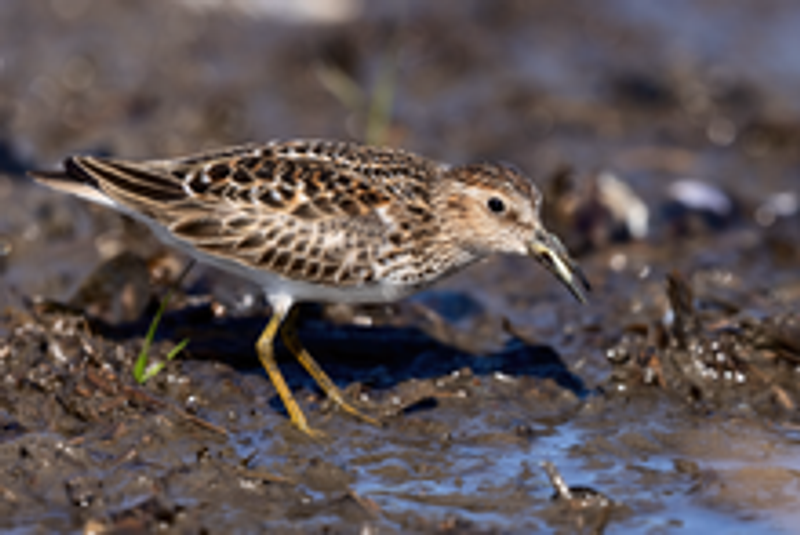
The least sandpiper is a species of shorebird known for being the smallest of its kind. Its scientific name, Calidris minutilla, is derived from Ancient Greek and Medieval Latin, giving us an insight into its past.
The genus name, Calidris, comes from the Greek term ‘kalidris’ or ‘skalidris’ used by Aristotle in reference to grey-colored birds near the water.
The species name, minutilla, is derived from the Medieval Latin term for ‘very small’, making it a fitting description of this tiny shorebird.
Despite its diminutive size, the least sandpiper is an important species in its natural habitats, playing a crucial role in the local ecosystems.
| Kingdom | Animalia |
| Phylum | Chordata |
| Class | Aves |
| Order | Charadriiformes |
| Family | Scolopacidae |
| Genus | Calidris |
| Species | C. minutilla |
Conclusion
Birds in Loreto are a critical part of the local ecosystems, providing food for many other species and contributing to the overall health of the region.
They also provide valuable aesthetic and cultural benefits, offering a unique opportunity to observe and appreciate nature’s beauty.
As such, it is essential to protect and conserve Loreto’s birds and their habitats, ensuring that future generations can continue to enjoy them for years to come.